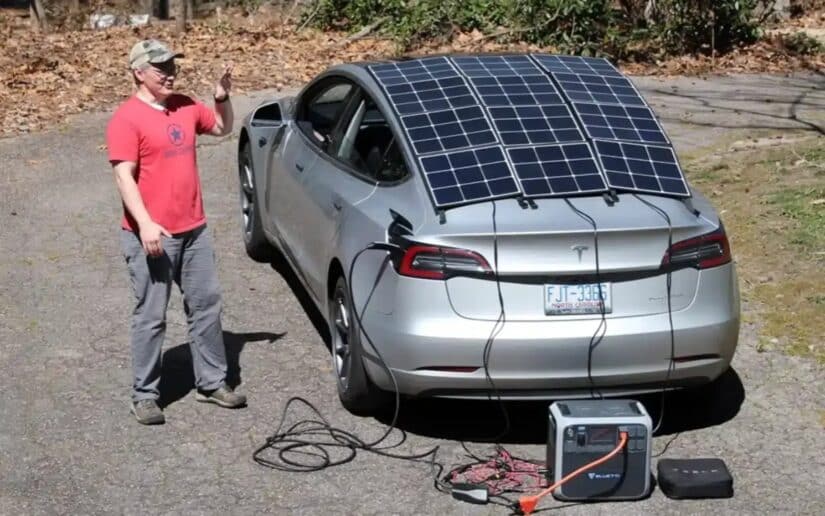
Electric vehicles like the Tesla Model S and Tesla Model 3 have become global icons of sustainable innovation. Among EV enthusiasts, there’s constant curiosity about new ways to keep these cars running, from Level 2 charging at home to using a mobile connector on the road. Recently, one Tesla owner attempted something highly unconventional: charging his car using solar panels.
The idea sparked a huge debate. Could a solar panel system really power a Tesla efficiently? Or is the reality of charging with sunlight more complicated? This blog explores what happened, how solar charging works, the technical hurdles of using a solar setup, and the future of renewable energy for EVs.
The Experiment: Solar Meets Tesla
The driver connected portable roof panels and a ground mount kit directly to his Tesla through an improvised solar inverter and battery bank. Using a basic AC inverter, the solar power was converted into usable energy for the car.
Surprisingly, the Tesla app did show that the car was charging. The problem? The charge rate was so slow that it highlighted the gap between ambition and reality. Even a Tesla Model 3 battery, with around 75 kWh capacity, required far more energy than portable solar panels could produce in reasonable time.
Why People Were Fascinated
For Tesla owners, especially those interested in off-grid camping or BLM camping, the idea of using a solar setup offers freedom. Imagine being able to drive into remote areas and still recharge using the sun. That’s the dream many EV enthusiasts share in communities like Tesla Motors Club.
But in practice, the experiment was limited by solar irradiance (the intensity of sunlight), panel efficiency, and AC losses during conversion. Even powerful systems such as a Samlex 3000 watt 24 volt inverter or advanced units like the EcoFlow DELTA Pro Ultra or Yeti 1400 face limits when trying to deliver the continuous high output needed for EV charging.
The Numbers: Why Solar Is So Slow
A Tesla battery can range from 50 kWh to over 100 kWh. A Goal Zero Boulder 200W portable panel, for example, produces about 200 watts in peak sun. To charge even half of a Model S battery would take hundreds of hours under ideal conditions.
Most home charging relies on Level 2 charging stations or wall chargers, which deliver far more consistent power. A 120V wall adapter, while slower, still outpaces direct solar panel charging in most conditions. Higher-output options like a Level 3 DC Fast Charge port show how far behind portable solar still is.
Safety and Management Concerns
Experiments like this also bring up safety issues. A Tesla relies on a sophisticated battery management system and features like a battery heater to regulate performance. Charging through makeshift setups with mismatched solar inverters or hybrid connections risks damaging both the vehicle and the charging equipment.
That’s why most engineers recommend regulated systems, often tied into net metering at home or part of a hybrid system combining grid power and solar. Without safeguards, an ad-hoc solar setup is more symbolic than practical.
Renewable Energy vs. Real-World Demand
While the test showed that charging is technically possible, the difference between a trickle charge and practical use is stark. Even advanced systems with devices like a Victron Shunt for monitoring still fall short of matching EV demands.
The reality is that current solar panel systems supplement charging but don’t replace infrastructure. For daily commuters or long-distance travelers, Level 2 charging at home or public Level 3 fast charging stations remain essential.
Community Reaction and Debate
Online, reactions were split. Some called the experiment visionary, pointing to the future where hybrid systems integrate EVs with renewable power. Others argued it was misleading, since no one could realistically drive cross-country using only a foldable solar setup.
Discussions across forums highlighted trade-offs: cost, efficiency, portability, and safety. Enthusiasts compared devices like the EcoFlow DELTA Pro Ultra, Yeti 1400, and Goal Zero Boulder 200W, debating their role in off-grid camping or emergencies.
The Road Ahead: Can Solar and Tesla Work Together?
While portable charging remains impractical, Tesla and other innovators continue exploring ways to bring solar into the EV ecosystem:
- Vehicle-Integrated Panels: Cars equipped with built-in roof panels or flexible cells.
- Improved Storage: Larger battery banks that store excess energy for later use.
- Smart Inverters: Advanced AC inverter designs to reduce AC losses.
- Hybrid System Models: Merging grid, solar, and battery backup for home charging.
- Public Infrastructure: Parking lots with solar panel systems connected to Level 2 charging stations.
Such measures point to progress, even if a single solar setup can’t yet meet the energy demand of a Tesla Model 3 or Model S on its own.
Closing Thoughts
The phrase “it worked… kinda” perfectly captures this solar charging experiment. The car did receive a charge, but the limitations of solar irradiance, small-scale solar setups, and conversion inefficiencies made it impractical.
Still, innovation begins with attempts like these. Whether through net metering, advanced hybrid systems, or portable solutions, renewable integration into EVs will continue to evolve. What seems unworkable today may inspire breakthroughs tomorrow.
About Ted Law
At Ted Law Firm, we see beyond the headlines and focus on the people affected. Whether cases arise from innovation, transportation, or unexpected tragedy, our foundation is built on fairness and accountability. We serve families across Aiken, Anderson, Charleston, Columbia, Greenville, Myrtle Beach, North Augusta and Orangeburg. In a world shaped by rapid change, Ted Law stands with communities and individuals, ensuring their voices are heard.Contact us today for a free consultation
